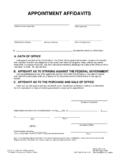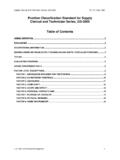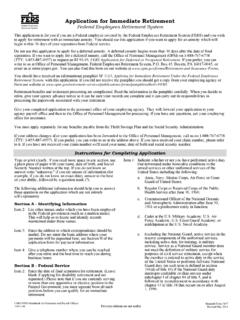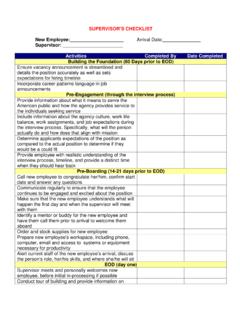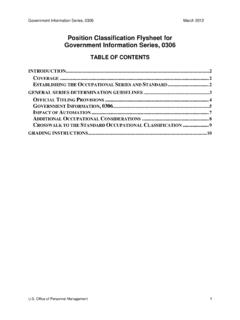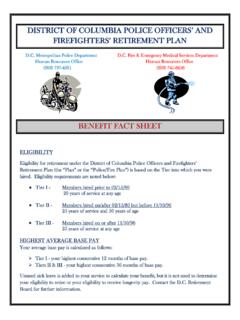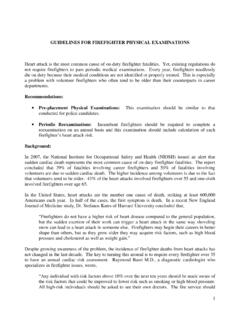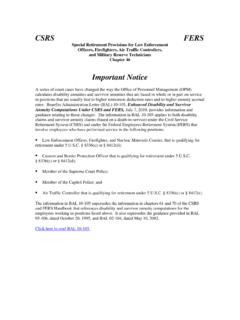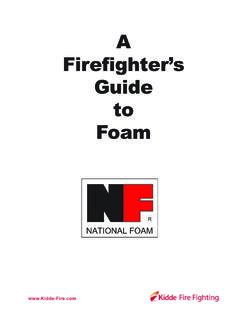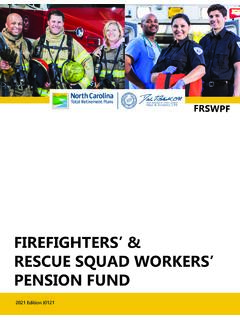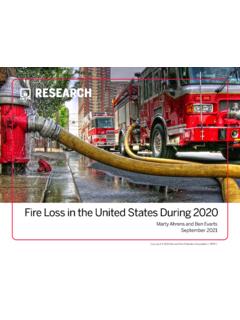Transcription of Position Classification Standard for Fire Protection and ...
1 Fire Protection and Prevention Series, GS-0081 March 2004 Position Classification Standard FOR FIRE Protection AND PREVENTION SERIES, GS-0081 Table of Contents 2 2 MODIFICATIONS TO THE PREVIOUS Standard .. 2 HAZARDOUS NATURE OF 3 OCCUPATIONAL 3 EVALUATION OF POSITIONS .. 4 ORGANIZATION OF THE Standard .. 5 DEFINITIONS OF 6 GENERAL TITLING GUIDANCE .. 11 CROSSWALK TO THE Standard OCCUPATIONAL 13 EXCLUSIONS .. 15 PART I FIRE CHIEF, SUPERVISORY, AND LEAD FIREFIGHTER 16 SECTION I DESCRIPTIONS OF TYPICAL POSITIONS .. 16 SECTION II Classification OF FIRE CHIEF 17 FACTOR 1 NATURE AND VARIETY OF FIRE HAZARDS .. 17 FACTOR 2 POTENTIAL SEVERITY OF FIRES .. 20 FACTOR 3 SCOPE OF SUPERVISORY RESPONSIBILITY.
2 23 FACTOR 4 FIRE PROGRAM 24 GRADE LEVEL DETERMINATIONS .. 27 GRADE CONVERSION OF FIRE CHIEF POSITIONS .. 27 SECTION III Classification OF SUPERVISORY AND LEAD FIREFIGHTER POSITIONS .. 28 PART II NONSUPERVISORY FIREFIGHTER AND FIRE Protection INSPECTOR POSITIONS .. 29 FIREFIGHTER, GS-0081-03 .. 29 FIREFIGHTER, GS-0081-04 .. 29 FIREFIGHTER, GS-0081-05 .. 30 FIRE Protection INSPECTOR, 31 FIREFIGHTER, GS-0081-06 .. 32 FIREFIGHTER (HAZARDOUS MATERIAL OPERATIONS), 33 FIRE Protection INSPECTOR, 34 FIREFIGHTER (BASIC LIFE SUPPORT), GS-0081-07 .. 34 FIREFIGHTER (HAZARDOUS MATERIAL TECHNICIAN), 35 FIRE Protection INSPECTOR, 36 FIREFIGHTER (INTERMEDIATE LIFE SUPPORT), GS-0081-08 .. 37 FIRE Protection INSPECTOR, 37 FIREFIGHTER (PARAMEDIC), GS-0081-09.
3 38 Fire Protection and Prevention Series, GS-0081 March 2004 Office of Personnel Management 2 INTRODUCTION This Standard provides a series definition, titling instructions, and grading criteria for positions in the Fire Protection and Prevention Series, GS-0081. COVERAGE This series includes positions that supervise or perform work to control and extinguish fires, rescue persons endangered by fire, and reduce or eliminate potential fire hazards. It also covers fire service positions that: Control hazardous materials incidents; Provide emergency medical services; Train personnel in fire Protection and prevention; Operate fire communications equipment; Develop and implement fire Protection and prevention plans, procedures, and standards; and Advise on improvements to structures for better fire prevention.
4 Positions in this series require knowledge of: Firefighting and fire prevention theory and techniques, Fixed and mobile firefighting equipment operation; and/or skill for planning, directing, or carrying out fire Protection and prevention programs and operations. Some positions may also require varying levels of knowledge regarding hazardous materials and/or emergency medical services. March 2004 MODIFICATIONS TO THE PREVIOUS Standard Issuance of this Classification Standard replaces the previous GS-0081, Fire Protection and Prevention Series Standard last revised in September 1991. This Standard is an updated and expanded Standard rather than a complete revision. It adds new occupational information and parenthetical titles.
5 The intent of this revised Standard is to recognize and address structural firefighting duties and responsibilities exercised in conjunction with emergency medical services and hazardous material response assignments. Positions in other series may continue to be assigned emergency medical or hazardous material responsibilities as primary or collateral duties but if the Position does not have a primary requirement for firefighting knowledge and skills, the Position must be classified using other standards. Because this Standard is not a complete revision, it retains the original narrative format. Many sections are exactly the same as the September 1991 version while some portions have been modified for readability without change in content.
6 The supervisory portion (Part I) of this Standard is largely unchanged. New information and modifications of existing material are primarily contained in the introductory material and Part II of this Standard . Fire Protection and Prevention Series, GS-0081 March 2004 Office of Personnel Management 3 Changes were not made to the fire Protection inspector criteria as they were outside of the intent of the revisions. The new information and modifications are identified by dated paragraphs. March 2004 HAZARDOUS NATURE OF FIREFIGHTING While most fires and hazardous materials incidents are kept under control, they all have the potential to cause physical harm to persons and/or property. firefighters are regularly exposed to a variety of dangerous situations such as fires that are out of control, toxic spills, or possible explosions.
7 Hazards encountered by firefighters include the potential for: Burns, dehydration, and other effects of heat, smoke inhalation, heavy protective clothing, falling materials, or explosions; Exposure to toxic materials and chemical, biological, radiological, nuclear, and explosive agents; Physical injury and sensory damage from firefighting activities and noise levels; Dealing with victims in varying stages of fright, panic, and injury; and/or Operating or riding on fire trucks under adverse conditions or flying in aircraft to reach crash sites or fires in outlying areas. These hazards make demands on the knowledge and judgment used by firefighters and on their physical ability to cope with the conditions.
8 firefighters must be prepared to avoid unnecessary dangers and to identify and deal effectively with hazardous situations when they are encountered. The knowledge, skills, and abilities required to deal with hazards of the kind typically encountered in this occupation have been considered in the evaluation criteria for this Standard . March 2004 OCCUPATIONAL INFORMATION Preparation and readiness is the cornerstone of the firefighting occupation. Successful response to emergencies requires preparing for the unexpected. firefighters are trained to react to a variety of conditions, which may occur at the installation or facility, with a response appropriate to the conditions encountered. Although firefighters follow established protocols or procedures and refer situations not covered by them to professionals, they must also quickly and independently gauge the situation, make a number of assessments, and choose from a variety of actions.
9 March 2004 Fire Protection and Prevention Series, GS-0081 March 2004 Office of Personnel Management 4 EVALUATION OF POSITIONS Fire departments vary greatly in their size, organizational structure, and equipment as they work to meet the needs of the environment ( , community, installation, or facility) that they serve to protect. Fire chiefs consider the range of fire hazards and other emergencies that may occur in determining the components and required level of service to be provided. In turn, these factors will dictate the positions and possible specializations needed in the fire department. Some organizations will not have certain types of specializations because these functions are performed by other installation components such as hospitals or clinics.
10 The appropriate grade of a Position is based on the duties and responsibilities of the Position and the appropriate qualifications or certifications for the Position rather than those possessed by the Position s incumbent. Firefighting personnel are expected to attain and maintain their assigned proficiencies, but the personal possession of certifications or qualifications beyond what is needed or required for a Position does not justify a higher grade. The necessity for readiness requires firefighters to often be trained for duties and responsibilities that they do not regularly perform. Duties demanding less than a substantial; , 25 percent amount of time are not usually considered in classifying or grading a Position .

